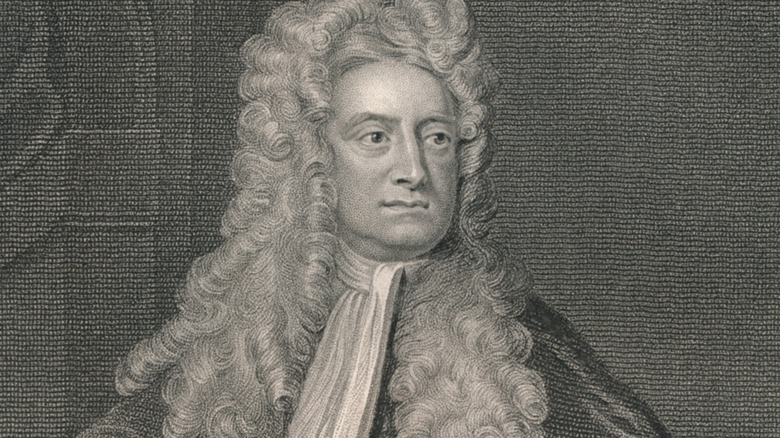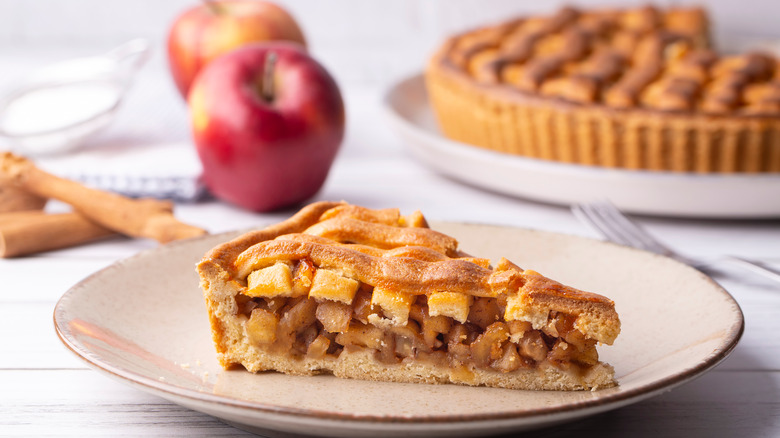The Type Of Apple That Likely Inspired Isaac Newton's Theory Of Gravity
In 1665, the Great Plague ravaged England, forcing Cambridge University to close up and send all of its students home. That is how a 22-year-old scholar found himself back at Woolsthorpe Manor in Lincolnshire in late summer. Despite just completing his BA, he had never really distinguished himself at Cambridge. Now, isolated at the family farmstead, he gazed out over the orchard, then watched as an apple fell from a tree with a thunk (via New Scientist).
Newton, to even engage with the gravity question, must've thought it was a curious thing. Why didn't it fall straight to the ground? Why not sideways or even upwards? This question ended up consuming young Newton. So much so that the fateful falling apple spurred him on two years of intense study at Woolsthorpe. Two years later, he published "The Principia: Mathematical Principles of Natural Philosophy," which outlined his universal laws of gravity. Nowadays, he is considered to be one of the greatest physicists who ever lived.
But while Isaac Newton may have answered some of the burning physics questions of his time, this story also raises some burning foodie questions. For instance, does that apple tree still stand? And what variety of apples fell from it? Surprisingly, the answer hasn't been lost over the centuries. It's not even impossible to sample the fruit, laced with cinnamon and baked into pies.
The fate of the famed tree
In fact, according to the University of York, the variety of apple that inspired Sir Isaac Newton was supposedly the rare Flower of Kent, which was cited in publications dating back to the 15th century. Although it's said that the original tree at Woolsthorpe fell over in a storm around 1816, it was re-rooted and still stands in the grounds over 350 years later. What's more, pieces of it traveled across England — including to Trinity College, Cambridge — where they were grafted onto rootstock. As explained by Orchard People, this is a process where two trees are fused into one, with the grafted part being the section that bears fruit. This process allows Isaac Newton's apple tree to potentially live forever.
And according to the UK's National Physics Laboratory, in 2015, British astronaut Time Peake took eight seeds from the original tree up to the International Space Station. They floated in microgravity for six months, then were brought back to Earth to be planted, including at biodome site, the Eden Project (via Cornwall Live). But what kind of apples does this tree actually produce?
Why Newton's apples are great for cooking
Nowadays, Flower of Kent apples are known as Isaac Newton's Tree Apples. These fruits are an heirloom variety, meaning they have been passed down through multiple generations. As explained by Red Tomato, heirloom apples have more diversity in taste, texture, and shape, as well as a greater complexity of flavor. Specialty Produce also describes Newton's apples as large and broad, with green skins and a red blush. In texture, they're both crisp and soft. These apples are also known as sub-acid, which means that they are a good balance of sweet and tart, allowing the flavors to sing in harmony (via Adam Apples). Although you can eat them fresh, they are better suited for cooking rather than grabbing them straight from the bowl. Their crispness and gentle tartness make them great for pies, and as they melt into a puree when cooked, you can turn them into a delicious apple sauce.
And if you'd like to see a Flower of Kent tree for yourself, you don't have to hoof it to England. According to MIT, a descendant of the original gravity tree stands proudly in the President's Garden of the campus, where it was planted in 1977 and bore fruit nearly 30 years later.


